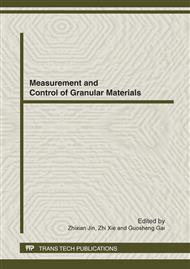p.175
p.180
p.184
p.188
p.192
p.196
p.200
p.203
p.207
A Study on Grinding Rate of Mica Particles
Abstract:
Grinding rate of mica particles by a planetary ball mill was studied by the measurement of specific breakage rate and breakage distribution parameter for different size ranges. The relationships between specific breakage rate and breakage distribution parameter with particle size were obtained from the measured results. The results show that grinding rate decreases fast as particle size decreases. Using integraldifferential equation for the mass fraction in grinding process with experimental obtained relationships of specific breakage rate and breakage distribution parameter with particle size, grinding process of mica particles are simulated by the 4th Runge-Kutta method, and particle size distribution between simulated and measured has been compared. The comparison results show that the specific breakage rate of mica particles was proportional to grinding time.
Info:
Periodical:
Pages:
192-195
Citation:
Online since:
April 2012
Authors:
Price:
Сopyright:
© 2012 Trans Tech Publications Ltd. All Rights Reserved
Share:
Citation:


